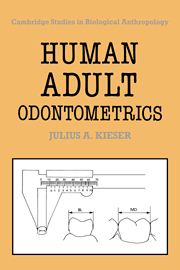Book contents
- Frontmatter
- Contents
- Foreword
- Preface
- 1 Introduction
- 2 Measurement of tooth size
- 3 Inheritance of tooth size
- 4 Comparative odontometry
- 5 Odontometric trends
- 6 Sexual dimorphism in tooth size
- 7 Odontometric variability
- 8 Compensatory tooth size interactions
- 9 Fluctuating odontometric asymmetry
- 10 Allometric relations of tooth size
- Odontometric appendix
- References
- Index
9 - Fluctuating odontometric asymmetry
Published online by Cambridge University Press: 05 February 2012
- Frontmatter
- Contents
- Foreword
- Preface
- 1 Introduction
- 2 Measurement of tooth size
- 3 Inheritance of tooth size
- 4 Comparative odontometry
- 5 Odontometric trends
- 6 Sexual dimorphism in tooth size
- 7 Odontometric variability
- 8 Compensatory tooth size interactions
- 9 Fluctuating odontometric asymmetry
- 10 Allometric relations of tooth size
- Odontometric appendix
- References
- Index
Summary
Introduction
In a thoughtful review of asymmetry in animals, Neville (1976) traced the origins of asymmetry back to a unique quality of the element carbon. With its valency of four, chemical groups may be bonded to carbon in one of two spatial configurations, resulting in the formation of two enantiomorphic isomers, which are mirror images of one another. At a slightly higher level, Neville related asymmetry to the sense of chirality or twist of biological helices. Since all biological helices are α-helices, the right-handed twist being favoured by hydrogen bonds, and since these helices are the same on both sides of the body, Neville reasoned that they too represented a type of structural asymmetry present in all living beings.
The origins of interest in the unequal manifestation of bilaterally symmetric structures in man and other animals is probably pre-Aristotelian. Modern interest in asymmetry originated with the writings of Charles Darwin and centred around the question of its inheritance. Darwin noted that even though ‘… it might have been anticipated, that deviations from the law of symmetry would not have been inherited,… a man who is left-handed, and a shell in which the spire turns in the wrong direction, are departures from the normal asymmetrical conditions, and they are well known to be inherited’ (Darwin, 1905, p. 545). Early observations on fiddler crabs and flat fishes had led Yerkes (1901) and Jordan & Evermann (1896) to assert that even though dextrality or sinistrality may not be inherited, the condition of asymmetry clearly was.
- Type
- Chapter
- Information
- Human Adult OdontometricsThe Study of Variation in Adult Tooth Size, pp. 96 - 111Publisher: Cambridge University PressPrint publication year: 1990



